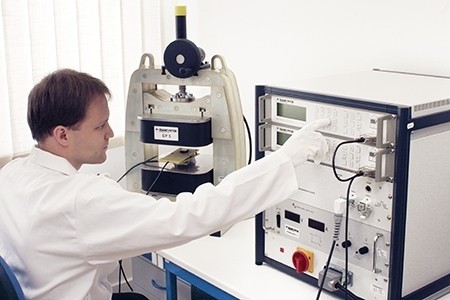Demagnetization BH curve
The BH curve shows the dependence of magnetic induction B, or polarization J, on intensity of demagnetizing magnetic field H in the second quadrant. The basic magnetic properties of permanent magnets read out of the demagnetization BH curve among others include the remanent flux density Br, coercivity HcB, internal coercivity HcJ, and energy product BHmax. Our accredited laboratory performs measurements of the demagnetization BH curve for all the current commercial types of permanent magnets:
Parameters of demagnetization BH curve:
The remanent induction Br - the residual magnetic induction in the magnet at the zero intensity of the magnetic field after the magnet has been saturated, is determined in the graph by an intersection point of the hysteresis loop and the coordinate axis B and equals to the magnetic polarization in this point.
Coercivity HcB - the magnetic field intensity at which the zero magnetic induction was reached after the magnet has been saturated, is determined in the graph by an intersection point of the B(H) hysteresis loop and the coordinate axis H in the 2nd quadrant.
Coercivity HcJ - the magnetic field intensity in the magnet at which the zero magnetic polarization was reached after the magnet has been saturated, is determined in the graph by an intersection point of the hysteresis loop J(H) and the coordinate axis H in the 2nd quadrant
Maximum energy product BHmax - the maximum value of BH product along the demagnetization curve; the maximum product equals to double energy density (volume unit energy) of the magnetic field in the magnet and corresponds to the largest rectangle under the BH curve in the graph.

Our testing laboratory possibilities
The given parameters of the permanent magnets can be measured by means of the hysteresisgraph, pulse magnetometer or other alternative methods. Our laboratories are equipped with the hysteresisgraph (accredited laboratory according to ISO 17025) - standardized method according to 60404-5 or ASTM A977/A977M, as well as the pulse magnetometer according to IEC TR 62331 that makes it possible to measure internal coercivity HcJ on all the types of permanent magnets, even SmCo (samarium-cobalt) magnets, this parameter of which cannot be measured by means of hysteresisgraph at a room temperature. Furthermore, our state-of-the-art equipment enables to measure these parameters for standard as well as complex shapes of magnets in the temperature range from -40°C to +220°C. When measuring the BH characteristic using the pulse method, we achieve the magnetic field induction up to 7T! However, neither the hysteresisgraph nor pulse magnetometers make it possible to measure all shapes, sizes and use all methods of magnetizing permanent magnets. The magnets with shapes and sizes too large or too small to be measured by means of the hysteresisgraph or pulse magnetometer are to be replaced with “standard samples” manufactured from the same production batch and these serve as a representative of the magnet material.
In our accredited laboratory we check:
- Properties of the magnetic material given in the specification
- Properties of the magnetic material at working temperature
Contact our specialist for more information.





